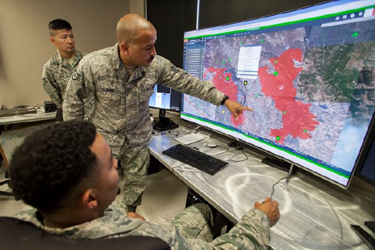The Benefits And Challenges Of Situational Awareness

By John Oncea, Editor

Technological advancements have greatly improved situational awareness on the battlefield. From drones to personal trackers and more, the data needed to stay one step ahead of the enemy has never been more plentiful. But while connecting military units in real-time has numerous advantages, there are still some challenges that need to be addressed.
The U.S. Army announced airborne troopers tested a new software package they feel will impact mission command at all levels on the modern battlefield. Soldiers used Mounted Mission Command Software Version 3.1 (MMC-S v3.1) when conducting planning, preparing, executing, and assessing during multiple 72-hour field training mission cycles. At the end of each mission cycle, they provided feedback in the form of surveys, focus groups, and mission effectiveness roundtable discussions.
Maj. Andrew Johnson, a test officer with the Mission Command Test Directorate of the U.S. Army Operational Test Command at Fort Cavazos, TX said, “The overall purpose of this test is to gather data to tell the Army and the Department of Defense whether this software is ready to be deployed. MMC-S aims to provide accurate digital command and control and situational awareness on the move.”
It’s that last outcome – situational awareness – that we’d like to dig into here, inspired by this article from the April edition of COTS Journal. In it, author John Reardon writes the United States Army Combat Capabilities Development Command (DEVCOM) is moving forward with solutions to address greater preparedness on the battlefield. One of the solutions DEVCOM is working on is the electrification of the fleet, primarily developing vehicles that can be self-sustained for seven days without needing recharging.
“They employ many Advance Driver Assistance Systems for autonomous operations and contribute to the driver through augmented reality,” writes Reardon. “They are advancing security around C2 and working to have increased situational awareness. Situational awareness will be their focus.”
The software DEVCOM is evaluating, as well as any technology helping improve situational awareness, could be the difference between winning and losing, life and death. As Base Camp Connect writes, “Without real-time unit locations, commanders can make decisions that give the enemy an advantage. Resources can be allocated to the wrong grids, artillery fire and close air support can be dropped where they are ineffective, and in some cases, degraded situational awareness can cause fratricide.”
Why Situational Awareness Is Crucial
As conflicts become more complex and dynamic, advanced technologies are changing how battles are being fought by providing unprecedented levels of situational awareness to military personnel. Base Camp Connect refers to tempo – moving when and how you want to – as one of the strategies benefiting from increased situational awareness.
“It has been said that the fundamental art and science of warfare is command and control. The efforts needed to achieve military objectives would be disorganized and ineffective without a well-developed command and control structure,” writes Base Camp Connect. “Leaders at all levels serving in command-and-control roles thrive on accurate data of troop locations and strengths.
“With real-time situational awareness, command and control become more fluid. Leaders with current troop locations can maneuver quicker and make better decisions. As new intelligence on enemy movements is acquired, friendly forces can respond faster and more effectively.”
Other benefits include the improvement of resource utilization, increases in the collection of data, and the ability to share intel quicker and with more efficiency. There are, however, challenges to achieving situational awareness including equipment interoperability, training, and data security. “Fortunately,” Base Camp Connect writes, “each of these challenges has solutions available to mitigate their potential adverse effects on maintaining real-time situational awareness.”
